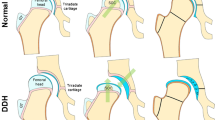Abstract
Introduction
The present study was designed to examine whether oblique radiographs (Judet views) in addition to 2D and 3D CT scans improved the intra- and interobserver reliability when assessing acetabular fractures.
Materials and methods
Four international orthopedic pelvic trauma centers reviewed the radiological images for 20 acetabular fracture patients. Three different image sets were made; one set containing plain radiographs including oblique (Judet) views and 2D axial CT scans. The second set contained an AP radiograph of the pelvis, without oblique views, 2D and 3D CT scans. The third set contained all the images. The image sets were evaluated in three separate sessions, for each session the raters were asked to classify the fracture according to Letournel, as well as record a number of other important radiological features concerning the fracture.
Results
The interobserver agreement for the Letournel classification was found to be moderate for all image sets. The image set without oblique views showed the best agreement with a kappa value of 0.60. The intra- and interobserver agreement for important modifiers were found to be substantial. The addition of oblique radiographs did not seem to increase the intra- or interobserver agreement for any of the factors evaluated except for the roof arc score.
Conclusion
The moderate agreement found for the Letournel classification is to be expected given the complexity of the classification. The addition of oblique radiographs to the image sets does not seem to improve the reliability and thus its routine use for classification and decision making may be debated.


Similar content being viewed by others
References
Martin JS, Marsh JL (1997) Current classification of fractures. Rationale and utility. Radiol Clin North Am 35:491–506
Bernstein J, Monaghan BA, Silber JS, DeLong WG (1997) Taxonomy and treatment—a classification of fracture classifications. J Bone Joint Surg Br 79:706–707
Colton CL (1991) Telling the bones. J Bone Joint Surg Br 73:362–364
Letournel E (1980) Acetabulum fractures: classification and management. Clin Orthop Relat Res 151:81–106
Judet R, Judet J, Letournel E (1964) Fractures of the acetabulum: classification and surgical approaches for open reduction. Preliminary report. J Bone Joint Surg Am 46:1615–1646
Letournel E, Judet R (1993) Fractures of the acetabulum, 2nd edn. Springer, Heidelberg
Marsh JL, Slongo TF, Agel J et al (2007) Fracture and dislocation classification compendium-2007: orthopaedic Trauma Association classification, database and outcomes committee. J Orthop Trauma 21:S1–S133
King JE (2011) Software solutions for obtaining a kappa-type statistic for use with multiple raters. http://www.ccitonline.org/jking/homepage/interrater.html. Accessed 11 Nov 2011
Gwet KL (2008) Computing inter-rater reliability and its variance in the presence of high agreement. Br J Math Stat Psychol 61:29–48
Landis JR, Koch GG (1977) The measurement of observer agreement for categorical data. Biometrics 33:159–174
Matta JM, Anderson LM, Epstein HC, Hendricks P (1986) Fractures of the acetabulum. A retrospective analysis. Clin Orthop Relat Res 205:230–240
Ovre S, Madsen JE, Roise O (2008) Acetabular fracture displacement, roof arc angles and 2 years outcome. Injury 39:922–931
Olson SA, Matta JM (1993) The computerized tomography subchondral arc: a new method of assessing acetabular articular continuity after fracture (a preliminary report). J Orthop Trauma 7:402–413
Visutipol B, Chobtangsin P, Ketmalasiri B, Pattarabanjird N, Varodompun N (2000) Evaluation of Letournel and Judet classification of acetabular fracture with plain radiographs and three-dimensional computerized tomographic scan. J Orthop Surg (Hong Kong) 8:33–37
Garrett J, Halvorson J, Carroll E, Webb LX (2012) Value of 3-D CT in classifying acetabular fractures during orthopedic residency training. Orthopedics 35:e615–e620
Beaule PE, Dorey FJ, Matta JM (2003) Letournel classification for acetabular fractures. Assessment of interobserver and intraobserver reliability. J Bone Joint Surg Am 85-A:1704–1709
Ohashi K, El-Khoury GY, Abu-Zahra KW, Berbaum KS (2006) Interobserver agreement for Letournel acetabular fracture classification with multidetector CT: are standard Judet radiographs necessary? Radiology 241:386–391
Audige L, Bhandari M, Kellam J (2004) How reliable are reliability studies of fracture classifications? A systematic review of their methodologies. Acta Orthop Scand 75:184–194
Shrout PE (1998) Measurement reliability and agreement in psychiatry. Stat Methods Med Res 7:301–317
Spitznagel EL, Helzer JE (1985) A proposed solution to the base rate problem in the kappa statistic. Arch Gen Psychiatry 42:725–728
O’Toole RV, Cox G, Shanmuganathan K et al (2010) Evaluation of computed tomography for determining the diagnosis of acetabular fractures. J Orthop Trauma 24:284–290
Patel V, Day A, Dinah F, Kelly M, Bircher M (2007) The value of specific radiological features in the classification of acetabular fractures. J Bone Joint Surg Br 89:72–76
Acknowledgments
Thanks to Wade Smith (Department of Orthopedic Surgery, Denver Health Medical Center, University of Colorado School of Medicine, Denver, CO, USA), Eero Hirvensalo (Department of Orthopedics and Traumatology, Helsinki University Hospital, Finland) and Matej Cimmermann (Deparmet of Traumatology, University Medical center, Ljubljana, Slovenia) for invaluable help in collecting the data.
Conflict of interest
None.
Author information
Authors and Affiliations
Corresponding author
Rights and permissions
About this article
Cite this article
Clarke-Jenssen, J., Øvre, S.A., Røise, O. et al. Acetabular fracture assessment in four different pelvic trauma centers: have the Judet views become superfluous?. Arch Orthop Trauma Surg 135, 913–918 (2015). https://doi.org/10.1007/s00402-015-2223-9
Received:
Published:
Issue Date:
DOI: https://doi.org/10.1007/s00402-015-2223-9




